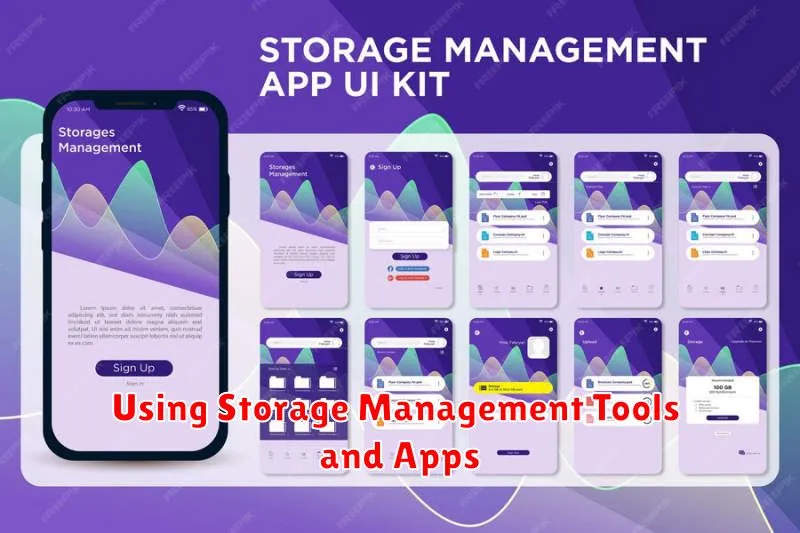In today’s digital age, our mobile phones have become indispensable tools, storing everything from cherished memories and important documents to essential apps and entertainment. As we accumulate more data, storage management becomes crucial. Are you constantly battling the dreaded “Storage Full” notification on your smartphone? This comprehensive guide, “Mastering Your Mobile: A Comprehensive Guide on How to Manage Storage on Your Phone Effectively,” provides you with the strategies and techniques needed to regain control of your device storage and optimize your mobile experience. We will explore practical methods applicable across various mobile phone operating systems like Android and iOS, offering solutions regardless of your technical expertise.
This guide delves into the intricacies of mobile storage management, offering actionable tips for identifying and removing unnecessary files, leveraging cloud storage effectively, and optimizing app usage to conserve valuable space. Whether you’re a casual user or a power user, “Mastering Your Mobile” equips you with the knowledge to efficiently manage your phone’s storage. From understanding the breakdown of your storage usage to implementing advanced techniques for data compression, this article is your ultimate resource for ensuring smooth performance and avoiding the frustrations of a perpetually full phone. Learn how to make the most of your device and say goodbye to storage woes for good!
Understanding Your Phone’s Storage Capacity
Before diving into managing your phone’s storage, it’s crucial to understand its capacity and how it’s allocated. Your phone’s storage is essentially its built-in memory, responsible for housing the operating system, pre-installed apps, personal files, and downloaded content.
Internal Storage vs. External Storage (SD Card): It’s essential to distinguish between internal storage (the phone’s built-in memory) and external storage, typically an SD card. Internal storage generally offers faster performance and is where the operating system resides. External storage can be used for media files and some apps, but performance may vary. Not all phones support external storage.
You can usually find your phone’s total storage capacity and remaining space within the device settings, often under the “Storage” or “About Phone” section. Check this regularly to stay informed about your available space and proactively manage your storage.
Identifying What’s Taking Up the Most Storage Space
The initial step in effectively managing your phone’s storage involves pinpointing the primary culprits consuming valuable space. Most smartphones offer built-in tools to analyze storage usage, typically found within the settings menu under sections like “Storage” or “Device Care.” These tools provide a breakdown of storage consumption by category.
Common Storage Hogs:
- Photos and Videos: High-resolution media files often constitute a significant portion of storage.
- Apps: Installed applications, particularly games and media-rich apps, can occupy substantial space.
- Downloaded Files: Downloads, including documents, music, and archives, can accumulate over time.
- System Files: The operating system and related files require a certain amount of storage.
- Cache and Data: App cache and data, while intended to improve performance, can grow excessively.
By utilizing the storage analysis tools on your device, you can gain a clear understanding of where your storage is being allocated and prioritize areas for optimization.
Deleting Unnecessary Apps to Free Up Space
One of the simplest and most effective ways to reclaim storage space on your phone is by deleting apps you no longer use or need. Many users accumulate apps over time that remain untouched, consuming valuable storage.
To identify these apps, navigate to your phone’s storage settings. Both Android and iOS devices provide lists of installed applications, often sorted by the amount of storage they occupy.
Prioritize uninstalling apps that consume the most storage and those you haven’t used in several months. Before deleting an app, consider whether its data is backed up or if you will need it again in the future. Remember that some apps offer web-based alternatives, allowing you to access their features without installing them on your device.
Here are the general steps to delete an app:
- Android: Go to Settings > Apps > Select the App > Uninstall. Alternatively, long-press the app icon on your home screen or app drawer and select “Uninstall.”
- iOS: Long-press the app icon on your home screen > Select “Remove App” > Confirm deletion.
Moving Photos and Videos to External Storage or Cloud Services
Photos and videos are notorious for consuming significant amounts of storage on mobile devices. To alleviate this, consider transferring these files to external storage solutions or utilizing cloud-based services.
External Storage Options
If your phone supports MicroSD cards, this provides a convenient and cost-effective solution. Simply move your photos and videos to the SD card via your phone’s file manager. Alternatively, you can use a USB flash drive with an OTG (On-The-Go) adapter to transfer files to a computer or other storage device.
Cloud Storage Services
Leveraging cloud storage services such as Google Photos, Dropbox, or iCloud offers automatic backups and accessibility across multiple devices. These services often provide a certain amount of free storage, with options to upgrade for more space. Remember to configure your settings to back up your photos and videos automatically.
Clearing App Cache and Data: What You Need to Know
App cache and data can accumulate over time, consuming significant storage space on your mobile device. Understanding the difference between the two and knowing how to manage them is crucial for effective storage management.
Cache refers to temporary files stored by apps to speed up performance. These files allow apps to load faster, but they can become substantial over time. Clearing the cache will remove these temporary files without affecting your login information or settings.
Data, on the other hand, includes more permanent information such as your login details, settings preferences, and saved progress within the app. Clearing app data will essentially reset the app to its initial state, as if you had just installed it.
Caution: Always be mindful when clearing app data, as you may lose saved information. It’s generally safer to clear the cache first and only clear the data if necessary.
To clear cache or data, navigate to your phone’s settings, find the “Apps” or “Application Manager” section, select the desired app, and then choose either “Clear Cache” or “Clear Data.”
Using Storage Management Tools and Apps

Mobile devices often come equipped with built-in storage management tools designed to assist users in monitoring and optimizing their storage usage. These tools provide a visual representation of storage allocation, categorizing data by type, such as apps, photos, videos, and system files.
Furthermore, various third-party applications are available on app stores that offer advanced storage management capabilities. These apps often include features such as:
- Cache cleaning: Identifying and removing temporary files that accumulate over time.
- Duplicate file detection: Locating and deleting redundant files to reclaim storage space.
- App usage analysis: Providing insights into app storage consumption and suggesting infrequently used apps for removal.
Before installing any third-party storage management app, it is essential to verify its authenticity and security to protect your device from potential malware or data breaches.
Optimizing Photos and Videos for Smaller File Sizes
Optimizing your photos and videos is a highly effective method for conserving valuable storage space on your mobile device. High-resolution media files can consume significant amounts of storage.
Photo Optimization Techniques
Consider adjusting your camera settings to capture photos at a lower resolution. Many smartphones offer options for reducing image quality, which can substantially decrease file sizes without significantly impacting visual appeal for everyday use. Utilize built-in editing tools or third-party apps to compress images after they’ve been taken.
Video Optimization Techniques
Similar to photos, videos can be optimized by reducing the resolution or frame rate. Explore video compression apps that allow you to shrink file sizes. Before deleting original high-resolution files, ensure the optimized versions meet your quality requirements.
Managing Downloads Effectively
The download folder on your mobile device can quickly become cluttered, consuming significant storage space. Effective management is crucial to maintaining optimal phone performance.
Regularly Review Your Downloads
Set aside time each week to review your download folder. Identify and delete files you no longer need. This includes documents, images, videos, and APK files.
Organize Your Downloads
Consider creating subfolders within your download directory to organize your files by type or project. This makes it easier to locate and manage your downloads.
Utilize Download Manager Apps
Explore using download manager apps which can help you pause, resume, and schedule downloads. Some apps also offer built-in file management features.
Be Mindful of Automatic Downloads
Be aware of apps that automatically download files, such as media received through messaging platforms. Configure these apps to avoid unnecessary downloads or to save them directly to external storage if available.
The Importance of Regularly Backing Up Your Data
Regularly backing up your phone’s data is crucial for data security and disaster recovery. Data loss can occur due to various reasons, including device malfunction, theft, accidental deletion, or software corruption. A recent study indicates that approximately 30% of smartphone users experience data loss annually.
Backing up your data ensures that you can restore your contacts, photos, videos, documents, and other important information even if your phone is lost or damaged. It provides a safety net against unforeseen circumstances. Backups can be performed to a computer, external hard drive, or cloud storage services.
Here’s a brief overview of backup methods:
- Cloud Backup: Automated and convenient, backing up data to services like Google Drive, iCloud, or Dropbox.
- Local Backup: Backing up data to a computer or external drive, offering more control over data security.
Implementing a regular backup schedule, whether weekly or monthly, is highly recommended to safeguard your valuable data.
Advanced Techniques for Freeing Up Storage Space

When basic storage management proves insufficient, consider these advanced techniques to reclaim valuable space on your mobile device.
Rooting/Jailbreaking (Use with Caution)
For advanced users, rooting (Android) or jailbreaking (iOS) allows access to system files. This enables the removal of pre-installed bloatware that cannot be uninstalled normally. However, proceed with extreme caution, as this voids warranties and can potentially brick your device if done incorrectly. Comprehensive research is critical.
Using a Custom ROM (Android Only)
Custom ROMs are alternative operating systems that can replace your phone’s default OS. Some ROMs are leaner, using less storage space and system resources than the stock ROM provided by the manufacturer. This option is only applicable for Android devices.
Partitioning Internal Storage (Advanced Android Users)
Partitioning your phone’s internal storage requires technical expertise, which involves reallocating space on the internal memory. This is a highly advanced method and carries significant risks if not executed properly.

